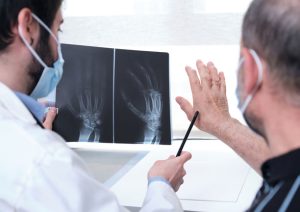
The Hidden Impact of Extra Weight on Your Bones, Joints, and Mobility
Learn how carrying extra weight impacts your bones, joints, and mobility. Discover expert tips and treatments from OrthoConnecticut for better joint health!

Learn how carrying extra weight impacts your bones, joints, and mobility. Discover expert tips and treatments from OrthoConnecticut for better joint health!

Arthritis and osteoarthritis are often used interchangeably but are distinct conditions with different causes, symptoms, and treatments. Understanding the nuances of each helps you better manage your joint health.Arthritis, a comprehensive term, encompasses a spectrum of conditions characterized by inflammation of the joints. There are over 100 types of arthritis, including osteoarthritis, rheumatoid arthritis, and psoriatic arthritis, among others. The common denominator among these inflammatory conditions is joint pain, stiffness, swelling, and decreased range of motion.Osteoarthritis is the most prevalent form of arthritis and typically develops with age or as a result of joint injury or obesity. It occurs when the protective cartilage that cushions the ends of bones wears down over time, leading to bone-on-bone contact, inflammation, and pain. Osteoarthritis commonly affects weight-bearing joints like the knees, hips, and spine.Distinguishing between arthritis and osteoarthritis is crucial for accurate diagnosis and effective treatment. While arthritis encompasses a broad spectrum of joint disorders, osteoarthritis specifically refers to the degenerative wear-and-tear of cartilage.Treatment approaches for arthritis and osteoarthritis vary depending on the underlying cause and severity of symptoms. Non-surgical interventions such as lifestyle modifications, physical therapy, medications, and injections may provide relief for mild to moderate cases. However, in severe or advanced osteoarthritis cases where conservative measures fail to alleviate symptoms, surgical options like joint replacement surgery may be considered to restore mobility and quality of life.At OrthoConnecticut, our team of orthopedic specialists is dedicated to diagnosing and treating arthritis and osteoarthritis with personalized care plans tailored to each patient’s unique needs. Whether you’re experiencing joint pain, stiffness, or swelling, we’re here to help you find relief and regain function.If you’re struggling with joint pain or suspect you may have arthritis or osteoarthritis, don’t hesitate to contact us. Schedule a consultation with one of our experienced orthopedic providers to explore your treatment options and take

Psoriatic arthritis is a chronic autoimmune disease that affects millions of people worldwide. It is a type of inflammatory arthritis that causes joint pain, stiffness, and swelling, and is often accompanied by the skin condition psoriasis. Doctors help patients identify the symptoms of psoriatic arthritis. Early diagnosis and management are key and there are many treatment options to alleviate discomfort and slow disease progression. What is Psoriatic Arthritis? Psoriatic arthritis is a type of arthritis that affects people who have psoriasis, a skin condition characterized by red, scaly patches on the skin. It is an autoimmune disease, which means that the body’s immune system mistakenly attacks healthy cells and tissues, causing inflammation and damage. Psoriatic arthritis can affect any joint in the body, but it most commonly affects the joints in the fingers, wrists, knees, toes and ankles. It can also cause inflammation in the spine, leading to pain and stiffness in the neck and lower back. Symptoms of Psoriatic Arthritis The symptoms of psoriatic arthritis can vary and change over time. Some common symptoms include: Not everyone with psoriatic arthritis will have all of these symptoms. Some people may experience mild joint pain, while others may have severe joint damage and disability. Diagnosing Psoriatic Arthritis Diagnosing psoriatic arthritis can be challenging, as its symptoms can be similar to other types of arthritis, such as rheumatoid arthritis. However, there are some key differences that can help doctors make an accurate diagnosis. Firstly, psoriatic arthritis usually affects the joints on both sides of the body, while rheumatoid arthritis typically affects joints on one side of the body. Additionally, psoriatic arthritis often causes swelling in the fingers and toes, while rheumatoid arthritis does not. To diagnose psoriatic arthritis, doctors will typically perform a physical exam, review the patient’s medical history, and order

Juvenile arthritis (JA) refers to a group of chronic inflammatory diseases that affect children and teenagers. An autoimmune condition, the exact cause of juvenile arthritis is not yet fully understood, but it is believed to involve a combination of genetic and environmental factors. It is important to work with a doctor to help guide you and your child through JA. The discussion of medication, pain management, physical activity, emotional support, and diet is critical to the overall well being of your child. It can seem overwhelming, but one of the easiest changes to make in the life of a child with JA is through food. Eating a healthy diet is important for any growing child, but children with juvenile arthritis (JA) face an additional challenge: Eating foods that promote growth and development and help quiet inflammation. Diet can play a role in managing the symptoms of juvenile arthritis. While there is no specific diet that can cure the condition, certain dietary choices may help reduce inflammation, support overall health, and improve symptoms. Here are some diet tips for managing pain in juvenile arthritis: Healthy eating should also be family-friendly. Eating to support a child with JA is good for the entire family, so avoid singling anyone out and ensure the entire family enjoys this healthy approach to nutrition and diet. Lastly, ask for help. It’s a great idea to work closely with a healthcare professional, such as a registered dietician in concert with your child’s rheumatologist, to help provide personalized dietary recommendations and guidance based on your child’s specific condition and needs. Related Resources:

Medically Reviewed by Dr. Angelo Ciminiello Key Takeaways Are you experiencing joint pain or stiffness and want to understand the progression of osteoarthritis? Osteoarthritis(OA) is a degenerative joint disease that results from the gradual breakdown of joint cartilage, which cushions the ends of bones and allows them to move smoothly against each other. As the cartilage wears down, bones may rub against each other, causing pain, stiffness, swelling, and other symptoms. OA can affect any joint, but it most commonly occurs in weight-bearing joints such as the hips, knees, and spine, as well as in the hands and feet. The exact cause of OA is not fully understood, but it is thought to be a combination of factors, including aging, genetics, previous joint injuries, and obesity. There is no cure for OA, but treatments such as pain management, physical therapy, and lifestyle modifications can help manage symptoms and slow the progression of the disease. In severe cases, joint replacement surgery may be necessary. The Four Stages Osteoarthritis is a degenerative joint disease that typically progresses slowly over time. There are generally four stages of osteoarthritis. Please note that not every person with osteoarthritis will experience all four stages, and the progression can be different for different people. Also, it’s always recommended to consult with a medical professional to determine the appropriate treatment options. Here are the signs and symptoms, diagnosis, and treatment options for each stage of osteoarthritis: Stage 1: Minor Signs and symptoms: Minor wear and tear in the joint with minimal symptoms, such as mild pain, stiffness, or swelling after physical activity. There may be slight joint space narrowing visible on X-rays. Diagnosis: Physical examination, X-rays, and MRI may be used to confirm the diagnosis and assess the degree of cartilage damage. Treatment: Treatment options may include lifestyle

July is Juvenile Arthritis (JA) awareness month and OrthoConnecticut is helping to raise awareness. Things to do – learn about JA, wear a blue ribbon, cook an anti-inflammatory recipe, make a donation, help raise awareness by telling your story, and host or attend a community event. Did you know? 300,000 – that’s how many children 16 or younger in the United States have JA (also known as pediatric rheumatic disease). For these kids (and their caregivers) an arthritic flareup frequently means coping with not only the physical symptoms of the disease but the emotional impact on kids including pain, loneliness, and depression resulting from lack of engagement in normal childhood activities with friends and family. What is JA? JA is a group of inflammatory and rheumatic diseases, but most children with JA have an autoimmune type where the immune system mistakenly views healthy tissue/cells as foreign invaders, and mistakenly perceives the need to fight these “invaders” creating arthritic pain in joints where two bones meet. Joint symptoms commonly include swelling, tenderness, warmth, stiffness, and inflammation. Less common symptoms include skin rash symptoms, eye pain/sensitivity, diarrhea, bloating, shortness of breath, fatigues, fever, or heart issues. Symptoms are broad because there are many types of JA including: juvenile idiopathic arthritis, juvenile myositis, juvenile Lupus, juvenile scleroderma, vasculitis, and fibromyalgia. OrthoConnecticut helps treat several types of Juvenile Arthritis and can work with your pediatrician and/or pediatric rheumatologist to prescribe the right treatment. Tips to Manage JA Healthy Eating for JA Kids with JA need to balance food for healthy growth and development while limiting those that are inflammatory. Arthritis.org recommends focusing on a diet with whole, unprocessed foods, whole fruit, vegetables, whole grains, legumes, and fatty fish. Food to emphasize in the diet include: Avoid or limit foods that can cause inflammation including:

Nine tips to help with Osteoarthritis If you’re middle-aged or older, it’s likely you have some Osteoarthritis in your hands, fingers, hips, knees, feet or spine. The most common form of arthritis, Osteoarthritis occurs when cartilage between joints and bone gradually wears away causing joint swelling, pain, stiffness, deformity, and reduced range of motion. Most often X-rays are used to diagnose and assess the amount of joint loss, or other issues that can occur like thinning bone, reduced joint space, joint fluid, or bone spurs. If you have osteoarthritis, here are some options your orthopedist might recommend. If you’re in pain, seek treatment and get help! Nonsurgical treatment for joint mobility, strength and pain relief can include: OrthoConnecticut recommends you consult your orthopedist surgeon for advice on surgical options, which might include: OrthoConnecticut Can Help Our physicians and physician assistants are available to diagnose and advise you on the best ways to treat your Osteoarthritis. Contact us today for an appointment and #getmovingCT.

By Lisa M. Cyr, OTD, OTR/L, CHT – Occupational Therapist / Hand Therapist, OrthoConnecticut OSTEOARTHRITIS (OA) is one of the most common joint disorders and is one of the leading causes of disability in the United States. It affects as many as 12% of the American population over 25. One in 4 women and at least 1 in 12 men will suffer from the pain and loss of function caused by osteoarthritis (OA) of the carpometacarpal joint (CMC) of the thumb during their lifetimes. When the smooth cartilage covering the ends of the bones in the thumb wears away, the bones rub against each other, causing friction and damage to the bones and the CMC joint. This can cause severe pain, swelling, and decreased strength and range of motion, making it difficult to do simple daily tasks. This may lead to loss of function, depression and decreased quality of life, causing many people to ultimately seek surgical intervention for relief. There are many potential causes for arthritis at the base of the thumb. Since the thumb is involved in at least 40% – 50% of every task that we do with our hands, it is subjected to many forces and strains throughout each day. Each time we pinch something between the fingertip and thumb tip, there is up to 25 times more force at the CMC joint than at the tip! Straining to open a new jar, holding a pen tightly when writing, buttoning tight buttons, pulling tight weeds, twisting a key in a stiff lock, trying to pull open a new bag of cereal or chips, holding pliers or other tools or overly large cups are all examples of ways we repeatedly strain our thumbs each day. Texting, with its repeated thumb motion, can irritate an already inflamed CMC
Call OrthoConnecticut today at 1.833.678.4628 to learn more or to schedule an appointment.
Accessibility statement
for individuals with disabilities:
We are committed to ensuring that our website and mobile applications are accessible to individuals with disabilities. Please use the blue icon in the lower right corner to access many helpful tools. If you need assistance using our website, or assistance with a document on the website, we can help you. Please contact us by email at info@myorthoct.com or by telephone at 1.833.ORTHOCT (1.833.678.4628).
1.833.ORTHOCT
(1.833.678.4628)



Accessibility statement
for individuals with disabilities:
We are committed to ensuring that our website and mobile applications are accessible to individuals with disabilities. Please use the blue icon in the lower right corner to access many helpful tools. If you need assistance using our website, or assistance with a document on the website, we can help you. Please contact us by email at info@myorthoct.com or by telephone at 1.833.ORTHOCT (1.833.678.4628).
We are committed to providing comprehensive care to Fairfield County, New Haven County, Litchfield County; New York State's Westchester, Dutchess, & Putnam Counties; and the Great Barrington region of Massachusetts.
This website provides general information about OrthoConnecticut, its practice areas and professional staff. Nothing in this website constitutes individual medical advice which may only be obtained as a result of personal consultation with a physician. Sending an e-mail to OrthoConnecticut, its physicians or office staff does not create a patient-physician relationship.
© 2025 OrthoConnecticut | Accessibility Statement | Site Map | Terms of Use | Non-Discrimination Policy | Website Design: Brandmark Studios